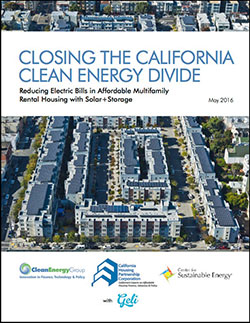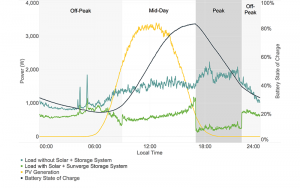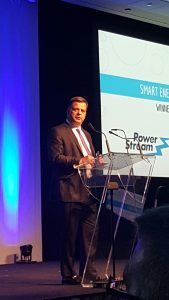In its coverage of the recent merger between SolarCity and Tesla, The Wall Street Journal ran a story focusing on the “extremely small” current market for energy storage – throwing in words like “miniscule” and “tiny” along the way. To me, the problem with that kind of coverage is that it tries to project the future from a myopic, single snapshot – it misses the bigger picture.
One of the most exciting things about our work at Sunverge is that our intelligent storage systems are integral to building our clean energy future. We’re developing great technology, along with great partnerships with solar installers and utilities who understand that the industry is at an important inflection point. The direction it is going matters a lot more than the size of the current installed base.
The future is also being built with the help of forward-thinking policy makers and regulators who are actively encouraging this transformation of the industry. They understand that properly designed networked storage deployments do more than deliver backup power and reliability to individual homeowners. They are a resource for the grid as a whole. This is more than theory: In New York, Sunverge, Consolidated Edison and SunPower are developing the largest deployment of distributed storage in North America, a 1.8 megawatt Virtual Power Plant. In Australia, energy retailer AGL and the Australian Renewable Energy Agency (ARENA) are building a Virtual Power Plant capable of storing 7 megawatt hours of energy.
As legislators and regulators also recognize this inflection point, they are taking steps to prove the benefits of storage and accelerate adoption.
In California, the legislature directed the Public Utilities Commission to establish requirements for utilities to deploy energy storage, and there are already several successful solicitations. A similar directive is in place in Oregon, and Sunverge has been actively providing comments and recommendations.
In Nevada, the PUC is investigating the benefits of storage and the best next steps to take. We’ve suggested, as we did in Oregon, that this begin with a systematic review of the capabilities of the electric power distribution system today. This is similar to what regulators in New York, in their Reforming the Energy Vision initiative, have required, with utilities providing distribution system implementation plans in July. And this summer, Massachusetts passed an energy bill that directs the state’s Department of Energy Resources to develop a plan for incorporating storage there.
We plan to continue to work with policy makers, and help them to understand the progress that’s already been made. It’s another way, besides technology, that we can help ensure that the energy future we build lives up to its potential.
Pretty much every business page on Wednesday covered Elon Musk’s second “master plan” around a future of sustainable energy. A significant component of that plan calls for combining rooftop solar panels with on-site storage into a single renewable energy package for the home.
It’s a great idea. It’s one that deserves media attention because it is important to the future of energy.
It’s such a good idea that we’ve been doing it at Sunverge for the past seven years. Working with our utility and installer partners, we’ve helped to create a seamless experience for hundreds of customers in the U.S., Australia, New Zealand and Canada.
We absolutely agree that solar+intelligent storage is the future of distributed energy resources, which in turn is the backbone of the development of the next-generation grid.
We’re moving rapidly to a future where, for example, there are millions of plug-in EVs in people’s garages – they will be 35% of new car sales by 2040. Effectively, we’re transferring the energy load of personal transportation from oil refineries producing gasoline and diesel fuel to the grid. Globally, power generation will grow 69% in the same period. The grid as it is now configured isn’t prepared for that shift; storage will have to provide much of that power and take the load off the system.
And that underscores some key places where our vision of the future differs from Mr. Musk’s, at both the micro and macro levels.
At the micro level, we think there’s incredible value in consumer choice. In fact, it’s mandatory. There are dozens of solar panel choices in the marketplace, and they use different technologies, and have different prices, efficiencies and warranties. There’s a reason for that: Every roof is different and every customer is different. The goal of “one-stop shopping” is terrific, and that’s what our partners offer. That’s not the same as “one size fits all,” which would assume Honolulu and Harlem need the same technology.
At the same time, panels have one function: Convert sunlight into electricity. The storage unit has to perform many functions: manage power consumption and load, help control individual devices in the home, operate for maximum efficiencies and cost savings.
Most important, storage has to integrate with the grid, and that’s where we differ on the macro level. The Master Plan’s goal to “empower the individual as their own utility” – in other words, to uncouple from the grid – is both unrealistic and inefficient. Solar+storage+the grid allows for resources at the edge to be aggregated, shared and efficiently managed. It adds significant levels of reliability and flexibility for everyone.
The only way you do that is with highly flexible and intelligent software control, which is where we are putting the majority of our resources. Our goal is to have software that is not only able to manage the individual storage unit and local demand, but also to connect back to the distribution grid. It will put “big data” to work on making the entire system better from the consumer on up. So the master plan’s focus on creating “stunning roofs” sort of misses the point. What really matters to the energy future is stunning software that makes the grid more resilient and saves customers money.
While a lot of the media attention about storage has gone to the large-scale projects undertaken in partnership with forward-looking utilities, a great deal of the expansion of the market comes from another source: Solar installers.
A large number of our partners are solar installers, so we weren’t surprised by this headline noting that the number of installers offering storage is set to grow dramatically this year. Storage is already offered by about a third of all installers because they understand it makes the most out of the solar generation capacity of the PVs they are selling – and has other significant advantages for their customers.
Most important is changing the payback equation for homeowners. As I’ve noted in a couple of recent posts, storage actually delivers about the same level of energy savings as solar, but for half the initial cost of PV. So if the cost recovery time for solar alone is 10 years, for example, adding storage reduces that to 7.5 years – a much more attractive proposition for installers to bring to the potential customer.
There are other great selling points for storage as well in the changing electric power environment. For one, intelligent storage that’s grid-enabled allows homeowners to take advantage of off-peak pricing and charge the battery with the cheapest grid power when needed. Then, the battery can be used to supplement solar, store extra solar, or use off-peak grid energy, under software control to maximize customer savings.
Just as important, the Sunverge SIS can provide backup power when the grid is down – a level of reliability that provides peace of mind that solar alone can’t.
Storage is more than just an attractive pitch to the customer, though. To me, it is the key to supporting the growth of business for installers in the face of new tariff structures and regulatory models. Adding storage into the mix creates a powerful economic case for customers and promises job growth.
For consumers, one of the major benefits of storage technology is driving down their energy bills, alone or in combination with renewable generation like rooftop solar. That’s why we’ve seen an increasing number of homeowners invest in the technology, either on their own or as part of a utility-led project.
So far, though, these benefits have accrued largely to more affluent homeowners who can afford to make the up-front investment in a Distributed Energy Resource (DER). That leaves out a big segment of the population: low-income families, particularly those in affordable rental housing (and there are 450,000 such families in California alone).
For these families, energy can represent a significant percentage of their monthly spending – an average of 7.2% and, in some cases, up to 35%. Finding ways for them to reduce their bills is a significant part of President Obama’s energy initiative announced last year; it includes plans to increase energy efficiency for 300,000 low-income households. And energy policy is sure to be one of the major policy debates of the coming presidential election.
Yet while there has been a lot of attention paid to getting solar PV installed on affordable rental units – and there are numerous programs and tax subsidies available to help low-income consumers benefit from solar – the same isn’t true for storage. Yet having storage incorporated as part of a low-income DER is just as important as solar PV — in fact, storage is a more cost-effective way for low-income households to reduce their bills than solar alone.
![“[T]he combination of solar and storage technologies could virtually eliminate electric bills for many owners of affordable housing properties.”](http://www.sunverge.com/wp-content/uploads/2016/07/Sunverge-solar-affordable-housing-delivering-energy-bill-savings-to-low-income-families-1024x512.png)
That’s one of the conclusions of this report that I’ve referenced in previous blogs, and it’s pretty direct: “[T]he combination of solar and storage technologies could virtually eliminate electric bills for many owners of affordable housing properties.”
The primary reason is that storage adds the essential flexibility for consumers to be able to avoid demand charges. Low-income families may not have the same flexibility as others to defer their energy needs to low-demand times, nor be able to afford intelligent home control systems or appliances. Reducing demand charges using storage can double the savings provided by solar alone according to the report.
Just as compelling is the finding that these storage-driven savings can be achieved for just a third of the cost of solar. Even if solar is not an option – for example, on buildings with insufficient roofprint or where structural issues make it impractical – storage can be used alone to derive significant savings for low-income families.
We have direct evidence of this with our partner the Glasgow Electric Plant Board in Kentucky, where Sunverge SIS storage systems are part of a pilot project aimed at reducing peak demand and using intelligence to recharge the batteries when costs are lowest. As reported here in Utility Dive, Glasgow’s goal was to reduce its demand peak by 25% — yet in a trial last fall, it was reduced by 64%, and the utility estimates that the project is saving each customer about $400 a year.
Making this a reality requires us to revise policies and programs aimed at making it possible for low-income households to participate. We will need to expand and extend to storage the kind of incentives we now provide for solar installations to private sector owners of affordable housing units. We also need to make it possible for low-income homeowners to acquire storage systems as well. Applied correctly, these incentives can provide direct benefits to both property owners and residents, a win-win that will help accelerate adoption.
It’s also important that we make incorporation of storage technology the norm in both existing and new public housing, where the savings can benefit residents and taxpayers alike.
By Ken Munson
Because the lion’s share of storage projects to date involve rooftop solar, it’s easy to think of storage as an extension of a PV installation. That has many people in the industry and in the media calculating the value of storage in terms of its ability to capture the otherwise unused power generated by distributed solar.
That’s a self-defeating view for both utilities and for consumers, because it obscures the much larger, true value of intelligent storage. In fact, I’m convinced that, over time, storage will make a much more significant contribution to our energy future than solar or any other specific source of DER generation.
An article in Public Power magazine last fall stated the reason clearly: Electricity “is the world’s longest supply chain that has almost no warehousing ability whatsoever.” What we are developing in our industry with ever-advancing storage and control technology is exactly the warehousing that’s been absent from the grid since the first wires were strung in the 19th Century.
Solar is going to play a huge role in the development of DERs and is helping drive the creation of “Grid 2.0.” There’s no question that utilities recognize this: Storage was named the top emerging technology in a Utility Dive survey of 400 utility executives last year, and utilities have continued to invest significantly in upgrading their infrastructure to deal with the consequences of the two-way power flows of DERs.

This recent report from the Clean Energy Group cites an example of how storage not only provided 90 percent more savings than solar alone – it did so for one-third the cost of putting PV panels on the roof.
Consider the findings of this recent report about the contribution of storage to reducing demand charges for low-income rental units in California. Storage not only provided 90 percent more savings than solar alone – it did so for one-third the cost of putting PV panels on the roof. Storage is simply the key component for delivering long-term value as the new grid is developed.
Some of the biggest advantages can accrue to municipal-owned utilities. In the past few years, Munis have seen power consumption decline or flatten (overall load growth in the U.S. hovers at a stagnant 1% a year). Combine that with the lower customer rates versus the cost to purchase power, and that can put them under a lot of economic pressure. Then consider that for many municipal utilities, solar isn’t a feasible option (sometimes for reasons of geography, sometimes for reasons of politics.)
So consider a situation that’s typical for some of these Munis. Take distributed generation out of the equation – but invest in the storage. Instead of charging the storage from a PV setup, charge it at off-peak hours (and prices). Then tap that power during peak demand. Utility costs are down, customer bills are down (if there is time-of-use billing), and reliability is up. That’s immediate value.
It’s even more valuable when you consider that there’s only so much you can do to shift natural demand from peak times – when wholesale rates skyrocket – to off-peak. Not too many people have heavy demand for hot water at 1 am, and most of them crank the AC or heat during the day and early evening hours.
That means also that the intelligence of the storage technology in use is vital to automatically make the right decisions. This should be a big topic of discussion at the APPA conference this month in Phoenix – and we’ll be there to talk about it.
By Ken Munson
At Sunverge we think of ourselves as changing the game in distributed energy with
intelligent storage that makes possible innovations like Virtual Power Plants. So we were proud that PowerStream, one of our key partners in Canada, was presented with the Game Changer Award for Smart Energy Management by the Canadian Solar Industries Association (CanSIA). PowerStream was recognized for its residential program incorporating rooftop solar PV and Sunverge SIS systems that the utility can aggregate into a Virtual Power Plant (VPP) using the Sunverge control platform.
While this is a pilot, the goal is to expand installations among the 380,000 customers PowerStream serves north of Toronto and in central Ontario. The award “acknowledges successful efforts to integrate solar into a holistic energy management environment,” in CanSIA’s words, and reinforces PowerStream’s commitment to “embrace the future of grid modernization”. This award underscores not just innovation but the value of a strategic partnership among forward-looking utilities, PV vendors and Sunverge.
The award also comes as the provincial government in Ontario is about to unveil a CDN$7 billion program to reduce greenhouse gas emissions in 2030 by 37 per cent from their levels in 1990. A significant part of the effort will be to switch to solar and reduce the use of natural gas for energy. VPPs will play a huge role in making this switch feasible and economical. Pilot projects like PowerStream’s are paving the way for this expansion and ensuring that Ontario’s grid will be up to the task.
Californians are used to annual warnings about conserving power during periods of peak demand in the summer. Usually, the underlying problem concerns the potential for demand to outstrip generation capacity or overload the transmission network. This year the ISO has issued that warning for southern California, but for a very different reason: Not enough natural gas to operate peaker plants, according to the Los Angeles Times.
The shortage stems from problems with a natural gas storage facility, which lost much of its stored gas through a leaking well and was forced offline for several months. It won’t be replenished in time for the hottest days of the summer (and long-range forecasts are for above-average temperatures this year).
This warning absolutely underscores how vital it is to deploy Distributed Energy Resources (DERs) that utilities can operate as Virtual Power Plants (VPPs) to provide alternative energy supplies to their customers. While it’s unusual for a large storage facility like the one near LA to be depleted, it’s just one of many events or circumstances that can lead to reliability issues in a grid based almost entirely on large-scale generation. Wind and rooftop solar generation along with storage provides an available, local power source that isn’t subject to those issues, and when combined with our software management platform, offers enormous flexibility in terms of aggregating and directing that power where it is most needed.
What has to go with that are business models and regulatory changes that bring out the full potential of DERs to both increase reliability and reduce emissions. New York has recognized this need, and when the Public Service Commission developed its Reforming the Energy Vision (REV) to re-engineer the business model of utilities, it made distributed generation a major part of the vision. Just last week the PSC approved new revenue models for utilities in the state that support alternative income streams from, among other things, managing distributed resources. That’s the kind of regulatory shift that’s needed to move DER and VPPs from demonstration projects to the mainstream, and get us closer to a new grid model that is resilient enough to deal with situations like the one in LA.
As Distributed Energy Resources (DERs) proliferate, utilities face increased demands to reduce the stress those installations can place on the grid. At the same time, consumer adoption is driven largely by the promise of realizing bill savings by generating their own power or storing low-cost energy for use at peak times.
These two forces might seem to be in opposition, but in reality DERs ca n deliver significant economic benefits on both sides of the meter — if DERs are properly managed. Doing so requires a dynamic approach that adjusts for the complex interaction of many factors of demand, storage capacity and energy price.
n deliver significant economic benefits on both sides of the meter — if DERs are properly managed. Doing so requires a dynamic approach that adjusts for the complex interaction of many factors of demand, storage capacity and energy price.
To address this need, Sunverge is adding sophisticated predictive analytics to its cloud-based DER management platform, making it the first company in the industry to offer this kind of control to utilities. This is an open, extensible platform that acts as the connecting hub from the edge of the grid to the generation side, and is compatible with most upstream standards and legacy transmission control systems.
The algorithms predict load and solar generation through the course of the day, accounting for everything from the likely amount of sunlight to the load conditions of the grid. They have been painstakingly designed to provide maximum value with minimum intervention by either the utility or the consumer, and continuously improve their predictive abilities as new data is generated by the consumer’s installation.
Using a simple interface, utilities can preset several parameters concerning when and how the consumer’s storage is charged or drawn down. These include specifying peak rate and shoulder periods per the customer’s tariff, during which stored energy use is preferred; setting time periods during which the consumer’s storage unit is allowed to charge itself using grid power, typically when low-cost power is most abundant; and identifying critical peak days that prioritize the use of stored power to offset peak load.
The algorithms use those settings, along with historic data for that specific home or business, to determine the exact behavior of the storage assets at that location. The algorithms will ensure that the battery has enough charge to satisfy peak period demand, while avoiding overcharging the battery, which would force the customer to curtail generation or export power to the grid. Additionally, the algorithm also avoids depleting the battery entirely, which would result in increased demand as the customer is forced to import all their energy usage from grid.
Should actual conditions vary from the predicted case, the software will apply intelligent corrections to maintain the most efficient operation possible within the set parameters. Consumers thus obtain the maximum value from their own generation (or, in storage-only installations, from charging as much as possible with the lowest-cost power).
This is an entirely automated process for consumers, one that meets the demand for bill savings without the need for them to actively manage their storage. Moreover, these algorithms are constantly learning and readjusting themselves as they obtain more data from consumers, creating a highly individualized set of decisions that would be impossible to make otherwise. The algorithms can begin predicting with a single day of usage data, and the accuracy augmented by the inclusion of solar forecasting and weather data.
For utilities, more precise and intelligent management of the charging and use of stored power behind the meter offers numerous benefits. First, it reduces the overall load created by DERs, which can delay or eliminate the need to upgrade feeders and substations in areas where DERs are widely deployed. In conjunction with the Sunverge platform’s ability to aggregate DERs into Virtual Power Plants (VPP), predictive analytics also represent a powerful energy arbitrage tool: Storage can be charged from the grid at lowest-cost times, while any power exported to other consumers through a VPP occurs primarily at times of high demand.
Using this powerful extension of the Sunverge platform can automate the entire intelligent decision process to drive value to both sides of the meter – including building a stronger relationship between utility and consumer.
Greentech Media ran an intriguing piece a couple of days ago about Warren Buffett’s analysis on the effect of renewables on the utility business, part of the Berkshire Hathaway annual report for last year. What caught my interest was a paragraph that pointed out a common viewpoint that the marketplace is a “battle” between those (like Buffett) who want to see renewables used for large-scale generation plants, and others who believe the solution is rooftop solar.
If you look at this as a zero-sum game, though, you’ll soon see that both approaches have significant problems. In fact, you can only create a true viable and profitable future for renewables by pursuing a cooperative, win-win solution.
Let’s look at the problem from the utility side as Buffett would have it. Large-scale (>100 GW) generation plants of any kind are hugely capital intensive; solar and wind are no exceptions. Most utilities in the current economic environment don’t have, or don’t want to commit, those kind of capital resources to a main generating plant. They’d rather build less expensive peaker plants that produce only when demand drives the price up. That only makes bottom-line sense, unless you’re somehow mandated to scrap and replace existing plants. Independent power producers, by the way, face the same economic constraints and will arrive at the same conclusion.
Even if you could ignore that huge capital drain, there’s another major problem with large-scale solar and wind installations that’s out of the control of the utility: Siting. Renewable plants like solar farms require significant amounts of land. It can’t be just any land, either: The very nature of the facility demands an ideal location (solar, for instance, does a lot better in the desert than anywhere else). Now, as much as environmentally conscious consumers want the power they buy to come from renewable sources, those same customers are among the first to oppose large-scale renewable facilities on the basis of possible damage to the local ecosystem. Good luck building your facility in the same decade you propose it (which adds even more to the cost above).
On the other side, while it would be great if we could meet every household’s energy needs with a self-contained rooftop solar or wind system, that’s never going to happen. Very few individual homes or even small businesses have enough “roofprint” to generate sufficient power to meet total need. Even assuming those installations have the latest high-capacity intelligent storage connected to the PVs, just about every consumer will need to get at least some power from the grid. It may be to provide supplemental power to meet their individual demand at times when they can’t generate enough from the array, or to just to recharge the battery. But they will have to rely on a reliable source somewhere out there on the grid.
So this either/or argument is the wrong way to look at the marketplace. The real solution is to build large-scale capacity at utility grade by aggregating those individual rooftop solar + storage systems. If utilities are able to control a wide range of DERs and manage them as if they were a single point of generation, you change the entire game. You wind up with Virtual Power Plants (VPPs) that can use the combined generation and storage capacities out there to put power on the grid and get it to where it’s needed. Each installation becomes a “nano producer” and participates in the market, while the utility applies its expertise to manage the power in aggregate (something the average consumer isn’t capable of doing, and has no interest in doing either).
So, yes, our energy future depends on installing lots more rooftop renewables in order to replicate the generating capacity of those impractical large-scale renewable plants. At the same time, you have to have utilities or independent producers managing this at scale.
For those who argue that what we really should do is get everyone off the grid – that’s a fantasy. Yes, there are cases where a particular installation has just the right combination of factors that it has the generation and storage capacity to operate entirely off the grid (although I’d still consider a backup generator). But for the vast majority of users, the grid remains essential.
So if you look at the future realistically, you’ll see it won’t be a battle where either utilities or solar providers “prevail.” Instead, it is a future where both the solar providers and the utilities have important and complementary roles to play. In this energy future, everybody wins: Solar providers through a booming business; utilities through new and profitable service-oriented business models; customers through lower costs and increased reliability; and the environment through greatly reduced emissions.
Our partners at PowerStream have received this year’s Innovation Excellence Award from the Electricity Distributors Association, which represents consumer-facing electric utilities in Ontario.
 PowerStream was recognized for its Advantage Power Pricing (APP) program, aimed at helping consumers realize significant savings by automatically reducing demand during peak periods of the day. The program provides consumers with detailed pricing information that they can view on a mobile device or can be fed into smart thermostats or controls for high-consumption appliances like water heaters. Consumers can use that information to change their own consumption patterns and shift as much electricity use as possible to off-peak times – and, as part of the program, get that power at a reduced rate.
PowerStream was recognized for its Advantage Power Pricing (APP) program, aimed at helping consumers realize significant savings by automatically reducing demand during peak periods of the day. The program provides consumers with detailed pricing information that they can view on a mobile device or can be fed into smart thermostats or controls for high-consumption appliances like water heaters. Consumers can use that information to change their own consumption patterns and shift as much electricity use as possible to off-peak times – and, as part of the program, get that power at a reduced rate.
We’re proud to be partnering with PowerStream, arguably one of the most progressive and customer-focused utilities in North America, on another bill reduction program. We launched a 20-home pilot with PowerStream in September, installing Sunverge SIS storage systems in those homes, which will be linked together into a Virtual Power Plant that PowerStream manages using our software platform. Not only will consumers get information about consumption and pricing, but they will have access to the stored PV-generated power when they need it – and that power can be redistributed on the grid as an additional peak resource.
Congratulations to PowerStream on this great award – more evidence of the increasingly important role technology is playing in creating the next generation power grid.

